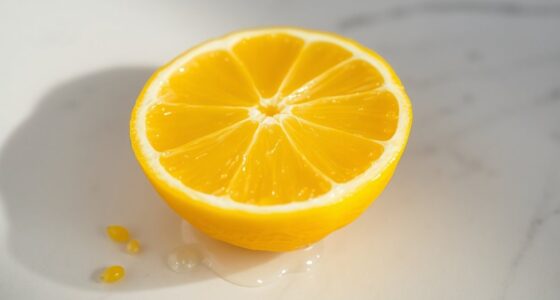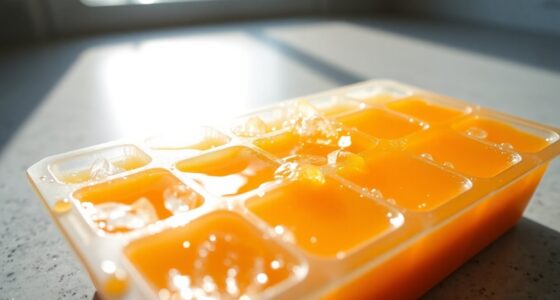A medium lime typically yields about 2 tablespoons, or 1 ounce, of juice. Larger limes can produce even more, while smaller ones may give less. For recipes requiring a significant amount of lime juice, consider that about 8 medium limes will provide 1 cup of juice. The juice extraction method also plays a role in yield, so be assertive when squeezing. Want to know more tips for maximizing your lime juice?
Key Takeaways
- A medium lime typically produces about 2 tablespoons (1 ounce) of juice.
- Each half of a lime yields approximately 1 tablespoon of juice.
- A pound of limes averages 8 to 10 tablespoons (1/2 to 2/3 cup) of juice.
- Ripe limes yield more juice; heavy limes are usually juicier.
- Proper squeezing techniques can maximize juice extraction from each lime.

Have you ever wondered how much juice you can squeeze out of a lime? If you've been in the kitchen, experimenting with recipes that call for fresh juice, you might've faced this very question. Understanding the yield of a lime can really make a difference, especially when you want to ensure your dish comes out just right. So, let's break it down.
Typically, a medium lime produces about 2 tablespoons, or 1 ounce, of juice. This means if you’re squeezing a ripe lime, you can expect that amount to be fairly consistent. However, keep in mind that the size matters; larger limes might yield a bit more, while smaller ones might offer less. When you’re after fresh juice, having a good estimate can save you from getting caught short. When selecting limes for juicing, it’s beneficial to consider their overall firmness and weight, as these factors often correlate with juice yield. In fact, the juice yield of a lime can significantly impact your recipes, especially in cocktails or marinades where precise measurements are key. To ensure you get the most out of your limes, try rolling them on a countertop before cutting, which can help break down the juices inside and increase your total yield.
If you're following a recipe that requires a significant amount of lime juice, like a zesty marinade or a refreshing cocktail, knowing the average yield can be crucial. For instance, if a recipe calls for 1 cup of lime juice, you're going to need about 8 medium limes. That's quite a few limes, but it's good to be prepared! Each half of a lime generally yields around 1 tablespoon of juice when properly juiced, so it's easy to see how the numbers add up quickly.
Now, you might be wondering how to make the most out of your limes. When you cut a lime, make sure to press down firmly and twist while squeezing. This technique encourages the maximum amount of juice to flow out. Whether you're using a juicer or just your hands, be assertive!
And don't forget, if you squeeze a half lime, you can usually expect about 1 tablespoon of juice.
When you buy limes, consider their ripeness. A ripe lime tends to produce more juice; as they age, they can dry out. So, if you're aiming for an abundant yield, go for the limes that feel heavy for their size. This indicates juiciness.
The average yield from a pound of limes usually falls between 8 to 10 tablespoons, which translates to about 1/2 to 2/3 cup of juice.
Frequently Asked Questions
How Many Limes to Make 1 Oz of Juice?
To make 1 ounce of juice, you only need one medium lime.
It's a simple calculation that streamlines your cooking process.
If you're measuring in tablespoons instead, remember that half a lime will yield about 1 tablespoon.
So, when you're planning your recipes or grocery shopping, just grab a lime, and you'll have the perfect amount of juice for your needs.
You'll find it's an easy addition to many dishes!
How Much Juice Does an Average Lime Yield?
When life hands you limes, you can expect an average lime to yield about 2 tablespoons of juice.
That’s roughly 1 ounce, perfect for your cooking or cocktails. If you’re whipping up a recipe that calls for 1 cup of lime juice, you’ll need around 8 limes. To get the most juice out of your limes, roll them on the countertop before cutting, as this helps to break down the cells inside and release more liquid. If you’re ever in doubt about how much juice from one lime, remember that an average lime yields about 2 tablespoons of juice. So, when you’re preparing that cup of lime juice, squeezing the 8 limes should do the trick!
With this consistency, you can easily estimate how many limes to grab, making your grocery shopping a breeze while you whip up something delicious!
Can I Substitute Bottled Lime Juice for Fresh Lime Juice?
Yes, you can substitute bottled lime juice for fresh lime juice, but keep in mind that the flavor won't be as vibrant.
You'll typically use a 1:1 ratio, but the taste might be flatter and less dynamic. If you're in a pinch, go for organic bottled options to minimize preservatives.
How Many Limes Are in a 2 Lb Bag?
When you pick up a 2 lb bag of limes, you'll typically find around 8 to 10 limes inside.
The exact number can vary depending on the size and weight of the limes. Heavier limes often mean juicier limes, so it's smart to choose a mix of sizes.
This way, you can maximize both your lime count and potential juice yield for your recipes or cocktails.
Enjoy your limes!
Conclusion
In sum, a lime typically yields about two tablespoons of juice, a zesty burst that can elevate any dish or drink. While it might seem small, this vibrant liquid packs a punch, enhancing flavors like sunshine on a cloudy day. So, the next time you squeeze a lime, remember that even the tiniest of fruits can bring a world of taste to your culinary creations. Keep experimenting, and let that lime juice work its magic!
Cindy thoroughly researches juicing trends, techniques, and recipes to provide readers with practical advice and inspiration. Her writing style is accessible, engaging, and designed to make complex concepts easy to understand. Cindy’s dedication to promoting the advantages of juicing shines through her work, empowering readers to make positive changes in their lives through the simple act of juicing.

















